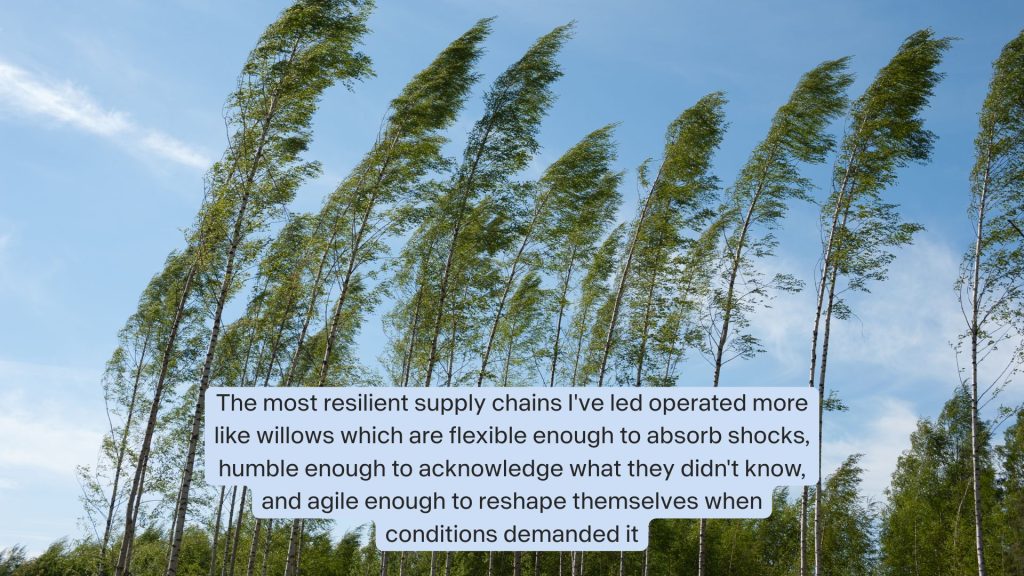Alan Watts once wrote that life is “all about balancing, not about being balanced.” For those of us who have spent years in the trenches of supply chain management, this insight resonates with particular force. We’ve been taught to pursue stability, to eliminate variability, to build fortresses of inventory and rigid contracts that promise predictability. Yet the most successful supply chain leaders I’ve encountered aren’t the ones who achieved perfect balance, they’re the ones who learned to dance with uncertainty.
The Illusion of Control
For decades, supply chain orthodoxy has preached the gospel of control. We invested billions in enterprise resource planning systems, sophisticated forecasting algorithms, and safety stock formulas where all designed to eliminate surprise and achieve that elusive state of equilibrium. We measured success by how closely our actual results matched our plans, how stable our inventory levels remained, how predictable our lead times became.
Then 2020 arrived, and the illusion shattered. Overnight, our carefully constructed models collapsed. Demand patterns became unrecognizable. Supply routes vanished. The very suppliers we’d partnered with for years disappeared from the map. Those organizations that survived best weren’t the ones with the most elaborate planning systems; they were the ones comfortable with improvisation.
Balancing vs. Being Balanced
Watts understood something profound: the difference between balancing and being balanced is the difference between living and being static. A tightrope walker stays upright not by achieving perfect stillness, but through constant micro-adjustments. They lean into the wobble, respond to the wind, and trust their ability to adapt.
Supply chains must adopt this same mindset. Being balanced suggests a destination where is a stable state that we can reach and maintain. But modern supply chains operate in environments of perpetual flux: geopolitical tensions shift trade routes, consumer preferences evolve overnight, climate events disrupt production, and technological innovations rewrite the rules of logistics. In this context, seeking a fixed state of balance is not just futile, it’s also dangerous.
Instead, we need organizations designed for continuous balancing. This means building capabilities that sense change quickly, decision-making processes that move at the speed of disruption, and teams comfortable operating without complete information. It means accepting that today’s optimal solution will be tomorrow’s constraint.
The Paradox of Resilience
Here’s where Watts’ wisdom becomes especially relevant: true resilience comes from embracing, not resisting, insecurity. Supply chain leaders often confuse resilience with rigidity. Building redundancy everywhere, maintaining excess inventory, over-engineering every process reduce our flexibility. But this approach creates brittle systems that work perfectly until they don’t.
Consider the difference between a glass and a willow tree in a storm. The glass is rigid, seemingly strong, but shatters under sufficient force. The willow bends, appears vulnerable, yet survives by yielding to the wind. The most resilient supply chains I’ve led operated more like willows which are flexible enough to absorb shocks, humble enough to acknowledge what they didn’t know, and agile enough to reshape themselves when conditions demanded it.

This doesn’t mean abandoning planning or accepting chaos. Rather, it means shifting from plans as predictions to plans as hypotheses. These are starting points that we expect to iterate and revise continuously. It means designing supply networks not for efficiency alone, but for optionality. Working with ranges might be a good approach. It means measuring success not just by cost reduction, but by how quickly we can pivot when assumptions prove wrong.
Cultivating the Improviser’s Mindset
So how do we cultivate this wisdom of insecurity in our supply chain organizations?
First, we must build comfort with ambiguity. This starts with leadership that openly acknowledges uncertainty rather than projecting false confidence. When leaders admit “I don’t know, but here’s how we’ll figure it out,” they give permission for the entire organization to operate honestly in the face of complexity.
Second, we need to develop scenario thinking (working with ranges) as a core capability. The aim is not to predict the future, but to expand our capacity to respond to it. The exercise of imagining multiple futures makes us less attached to any single vision and more prepared to recognize when reality deviates from expectation.
Third, we must invest in relationships over contracts. When disruption hits, it’s not the legal terms that save you. It’s usually the supplier who takes your call at midnight, the logistics partner who finds creative solutions, the internal colleagues who collaborate across silos. These relationships require ongoing attention and genuine reciprocity, not just transactional efficiency.
Finally, we need to celebrate adaptation, not just execution. Most supply chain KPIs reward meeting plan. But in a world of constant change, we should equally recognize the team that pivoted successfully, the leader who called an audible that saved the quarter, the analyst who saw the early warning signal others missed.

Dancing with Uncertainty
Alan Watts reminds us that “the only way to make sense out of change is to plunge into it, move with it, and join the dance.” For supply chain leaders, this is both a philosophical insight and a practical imperative. The question is no longer whether we’ll face disruption, but whether we’ve developed the wisdom to dance with it.
The most secure supply chain isn’t the one that’s eliminated all risk, it’s the one that’s learned to balance.
